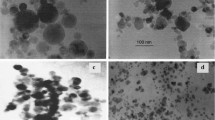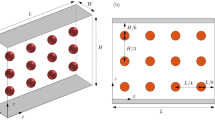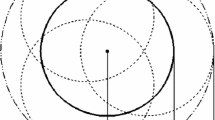Abstract
This work presents a cell model for predicting the thermal conductivity of nanofluids. Effects due to the high specific surface area of the mono-dispersed nanoparticles and the micro-convective heat transfer enhancement associated with the Brownian motion of particles are addressed in detail. Novelty of the paper lies in its prediction of the non-linear dependence of thermal conductivity of nanofluids on particle volume fraction at low particle concentrations. The model is found to correctly predict the trends observed in experimental data over a wide range of particle sizes, temperatures and particle concentrations.










Similar content being viewed by others
Abbreviations
- A m :
-
Heat transfer area per particle for conduction through liquid medium (m2)
- A pc :
-
Volume averaged cross-sectional area for conduction through nanoparticle (m2)
- A ps :
-
Surface area of nanoparticle (m2)
- c :
-
Empirical constant
- d p :
-
Average particle diameter (m)
- dT/dx :
-
Temperature gradient (K/m)
- h :
-
Convective heat transfer coefficient (W/m2 K)
- k b :
-
Boltzmann constant (J/K)
- k m :
-
Thermal conductivity of liquid medium (W/m K)
- k p :
-
Thermal conductivity of particle (W/m K)
- l :
-
Length scale of the unit cell (m)
- Nu :
-
Nusselt number
- n :
-
Number of nanoparticles per unit volume of nanofluid
- Pe :
-
Peclet number
- q m :
-
Heat flux in liquid medium by conduction (W/m2)
- q nf :
-
Overall heat flux in nanofluid (W/m2)
- R c :
-
Thermal resistance of micro-convection (K/W)
- R eff :
-
Effective thermal resistance of the nanofluid system (K/W)
- R m :
-
Thermal resistance of conduction in liquid medium (K/W)
- R p :
-
Thermal resistance of a particle (K/W)
- T :
-
Temperature (K)
- u p :
-
Particle velocity due to Brownian motion (m/s)
- eff:
-
Effective
- m:
-
Liquid medium
- nf:
-
Nanofluid
- p:
-
Particle
- α:
-
Thermal diffusivity (m2/s)
- ɛ:
-
Particle volume fraction
- η:
-
Dynamic viscosity (N s/m2)
References
Chon CH, Kihm KD (2005) Thermal conductivity enhancement of nanofluids by Brownian motion. Trans ASME, J Heat Transf 127:810
Das SK, Putra N, Thiesen P, Roetzel W (2003) Temperature dependence of thermal conductivity enhancement for nanofluids. ASME J Heat Trans 125:567–574
Das SK, Choi SUS, Patel HE (2006) Heat transfer in nanofluids review. Heat Transf Eng 27(10):3–19
Eastman JA, Choi SUS, Li S, Yu W, Thomson LJ (2001) Anomalously increased effective thermal conductivities of ethylene glycol based nanofluids containing copper nanoparticles. Appl Phys Lett 78:718–720
Einstein A (1956) Investigations on the theory of the Brownian movement. Dover, New York
Gao L, Zhou XF (2006) Differential effective medium theory for thermal conductivity in nanofluids. Phys Lett A 348:355–360
Hamilton RL, Crosser OK (1962) Thermal conductivity of heterogeneous two component systems. I & EC Fundam 1:187–191
Hemanth KD, Patel HE, Rajeev KVR, Sundararajan T, Pradeep T, Das SK (2004) Model for heat conduction in nanofluids. Phys Rev Lett 93:144301-1–144301-4
Hong TK, Yang HS, Choi CJ (2005) Study of the enhanced thermal conductivity of Fe nanofluids. J Appl Phys 97:064311-1–064311-4
Jaiswal AK, Sundararajan T, Chhabra RP (1991) Hydrodynamics of Newtonian fluid flow through assemblages of rigid spherical particles in intermediate Reynolds number regime. Int J Eng Sci 29(6):693–708
Jang SP, Choi SUS (2004) Role of Brownian motion in the enhanced thermal conductivity of nanofluids. Appl Phys Lett 84:4316–4318
Keblinski P, Phillpot SR, Choi SUS, Eastman JA (2002) Mechanisms of heat flow in suspensions of nano-sized particles (Nanofluids). Int J Heat Mass Trans 45:855–863
Lee S, Choi SUS, Li S, Eastman JA (1999) Measuring thermal conductivity of fluids containing oxide nanoparticles. J Heat Trans 121:280–289
Lee D, Kim JW, Kim BG (2006) A new parameter to control heat transport in nanofluids: surface charge state of the particle in suspension. J Phys Chem B 110:4323–4328
Li CH, Peterson GP (2006) Experimental investigation of temperature and volume fraction variations on the effective thermal conductivity of nanoparticle suspensions (nanofluids). J Appl Phys 99:084314/1–084314/8
Maxwell JC (1881) A Treatise on electricity and magnetism, 2nd edn., vol 1. Clarendon Press, Oxford, UK
Murshed SMS, Leong KC, Yang C (2005) Enhanced thermal conductivity of TiO2-water based nanofluids. Int J Therm Sci 44:367–373
Prasher R, Evans W, Meakin P, Fish J, Phelan P, Keblinski P (2006) Effect of aggregation on thermal conduction in colloidal nanofluids. Appl Phys Lett 89:143119
Sanyal D, Sundararajan T (1992) An analytical model of spray combustion for slowly moving fuel drops. Int J Heat Mass Transf 35(5):1035–1048
Wang X, Xu X, Choi SUS (1999) Thermal conductivity of nanoparticle-fluid mixture. J Thermophysics Heat Transf 13:474–480
Wang B, Zhou L, Peng X (2003) A fractal model for predicting the effective thermal conductivity of liquid with suspension of nanoparticles. Int J Heat Mass Transf 46:2665–2672
White FM (1991) Viscous fluid flow. McGraw-Hill, New York
Xuan Y, Li Q (2000) Heat transfer enhancement of nano-fluids. Int J Heat Fluid Flow 21:58–64
Xuan Y, Li Q, Hu W (2003) Aggregation structure and thermal conductivity of nanofluids. AIChE J 49:1038–1043
Xue QZ (2003) Model for effective thermal conductivity of nanofluids. Phys Lett A 307:313–317
Yang B, Han ZH (2006) Temperature-dependent thermal conductivity of nanorods-based nanofluids. Appl Phys Lett 89:083111
Acknowledgements
The authors acknowledge the support from Defence Research and Development Organisation (DRDO) and Department of Science and Technology (DST), Government of India, for the present research work.
Author information
Authors and Affiliations
Corresponding author
Rights and permissions
About this article
Cite this article
Patel, H.E., Sundararajan, T. & Das, S.K. A cell model approach for thermal conductivity of nanofluids. J Nanopart Res 10, 87–97 (2008). https://doi.org/10.1007/s11051-007-9236-4
Received:
Accepted:
Published:
Issue Date:
DOI: https://doi.org/10.1007/s11051-007-9236-4




